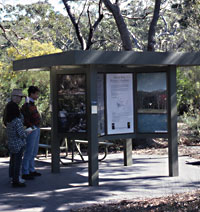Historical Documents
Jervis Bay Botanic Gardens until 1995 (later Booderee Botanic Gardens)
The Jervis Bay Botanic Gardens was an Annexe of the Australian National Botanic Gardens until 1995. The ANBG occupied a 90 ha site in Canberra and an 80 ha site at Jervis Bay. The information below relates to the management of the Jervis Bay Gardens when it was an Annex of the Australian National Botanic Gardens up until 1995. It has now been handed back to the tradional Aboriginal community at Wreck Bay to be managed jointly with Parks Australia within the Department of the Environment as the Booderee Botanic Gardens.
The Gardens at Jervis Bay were established in 1951 to provide frost-free growing conditions for many plants unsuited to Canberra's climate. The Gardens combined cultivated and natural areas and are set around Lake McKenzie, a naturally occurring lake.
Location of the Jervis Bay Annexe
History of the Jervis Bay Annexe
 Layout of the Gardens
Layout of the Gardens
In addition to decorative plantings, the Gardens' plant displays were organised into taxonomic or ecological groups. Taxonomic displays featured related plants, such as wattles (Acacia species); ecological displays contained plants which grew in similar environments, such as rainforests.

Map from 1987
The Gardens' Environment
The base rock of the Gardens is sandstone, although much of the site is covered with old sand dunes. Sandstone outcrops, swamplands and wet gullies are a common part of the landscape.Lake McKenzie is a naturally occurring lake. The dark brown water has been stained by pigments form decaying vegetation. Sunlight cannot penetrate far into the waters and the lake is very cold. It does not support fish, but large numbers of Long-necked Tortoises live in the lake.
The average annual rainfall of Jervis Bay is 1170 mm, most of which falls in winter. The wettest month is May, the driest is October. The temperatures range between an average maximum of 24 degrees C in January and an average minimum of 9.5 degrees C in July.
Propagating Plants
Most of the plants in the Gardens were propagated from cuttings collected in the wild. The Jervis Bay Botanic Gardens had a small nursery to propagate plants, and some were supplied from the nursery of the ANBG in Canberra. Some of the collections which require glasshouse conditions in Canberra were transferred to Jervis Bay.Exploring the Gardens
A number of marked paths allowed you to explore the Gardens. All walks were marked with arrows on wooden posts.General Walks for everyone to enjoy
The Blue Arrow Walk - a short introduction to the Gardens. 1.3 km, 30 minutes easy walk. With few steps.On this short walk you could see the heart of the Gardens' landscape - Lake McKenzie. You would pass by areas which were being developed to display the lush beauty of Australian native ferns and by the site of Bherewerre Farm, the homestead previously on the site. A display about Australian plants could be found in 'The Green Hut' near the lake. A stroll through the Rainforest Gully was a highlight of the walk.
The Yellow Arrow Walk - see the beauty of Australia's native plants. 1.5 km, 45 minutes easy walk. A few steps.
This walk passed through areas of natural bushland, as well as cultivated areas.There are magnificent views across the Gardens as you pass along the sandstone ridge at the beginning of the walk. A highlight of the walk was the cool and shady Rainforest Gully. Near the Gully, was the collection of Australian palms and the bright flowers of Australian and Papua-New Guinean rhododendrons. Tiny mosses and lichens covered the sandstone outcrops along the paths - the Gardens is especially rich in these fascinating plants.
Orange Arrow Walk - the Gardens' natural beauty. 1.1 km, 30 minutes walk. Wet in places.
This short walk introduced you to the Gardens' natural bushland of scribbly gums and heath. The walk also passed by garden beds planted with members of particular plant families. Wattles, grevilleas, bottlebrushes, and tea trees were special features. Some of the Gardens' collection of plants at risk in the wild could also be seen from the walk.
Trails - for those who enjoy a long stroll
The Lake Trail A sandy track not suitable for strollers. 2.6 km, 1.5 hours.Reach the trail by following the Yellow Arrow Walk to the beginning of the trail located near the Rainforest Gully.
Lake McKenzie is the central feature of the landscape of the Gardens. This trail lead around the edge of the lake and offered beautiful vistas of the Gardens across the lake. The plants along the trail were mostly part of the natural bushland. The exposed areas on the north-facing slopes on the southern of the lake support a less lush vegetation than the sheltered east-facing slopes on the southern side of the lake, and it is fascinating the see the gradual change along the trail.
The Bushland Trail The walk could be wet in places. 1.7 km, 1 hour.
The trail could be reached by following the Orange Arrow Walk. The trail later re-joins this Walk.
The trail lead through some of the different types of bushland at the Gardens. The heathland, with its dense cover of small, woody shrubs was especially beautiful in spring, and the home for many small animals, especially birds and reptiles. The NSW Christmas Bush grew in sheltered areas, while tiny ground orchids, sundews and grass trees were common throughout the area.
Please Note: Unless otherwise indicated, water in the Gardens is not suitable for drinking.
Opening Hours (up until 1995)
- Weekdays: 8 am to 4 pm
- Sundays and Public Holidays: 10 am to 5 pm.
- The Gardens is closed Saturdays, Good Friday and Christmas Day.
General Regulations (up until 1995)
- To preserve the gardens for the enjoyment of all, flowers, seeds or any other plant material are not to be picked or removed from the site.
- The Gardens is a pedestrian area, bicycles and private vehicles are not permitted.
- For the safety of the Gardens' wildlife, domestic animals, other than guide dogs, are not permitted.
- To reduce the danger of fire, open fires and barbecues are not permitted.
- To assist in the maintenance of the Gardens, visitors are requested to keep to the paths and not to climb on rocks or in trees.
![Director of National Parks [logo]](../../../../images/dnp_90px.gif)






